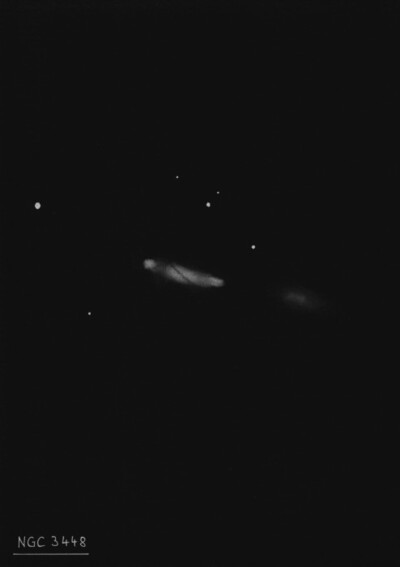
William Herschel discovered NGC 3448 = H I-233 = h788 on 17 Apr 1789 (sweep 922) and logged "vF, L, E 20° sp to nf, r." On 10 Feb 1831 (sweep 324), John Herschel wrote,"B; mE; gbM; no nucl; 1 3/4' l, 20" br; pos = 67°."
R.J. Mitchell, observing on 8 Mar 1856 at Birr Castle, recorded "mE, certainly dark spaces on each side of the nucleus, but not well seen; the foll one rather more distinct. A sketch or diagram matches the photographic appearance with brighter knots at each ends of the extensions.
400/500mm - 17.5" (3/12/88): fairly bright, moderately large, very elongated 3:1 WSW-ENE, halo increases to a small bright core. A mag 13.5 star follows 3.1' from center. An extremely faint knot is visible east of the core along the major axis about 35" from the center. Located 19' SE of 44 Ursa Majoris (V = 5.1).
900/1200mm - 48" (5/16/12): this interacting starburst galaxy appeared very bright, large, very elongated 3:1 WSW-ENE, high surface brightness, irregular shape, mottled appearance. At the northeast end of the galaxy is a large, bright knot, ~25"x12", which is possibly the disrupted core of the galaxy. Occasionally an extremely faint tidal tail could be glimpsed, extending perhaps 1.5' ENE. The beginning of the tail near the bright knot was easily seen. At the very tip was a marginally visible galaxy, perhaps glimpsed a couple of times. The dim tail extends the length from 2.4' to 3.6'.
NGC 3448 is interacting with UGC 6016, a low surface brightness dwarf galaxy, 4.1' WSW. The companion appeared as a faint to fairly faint, low surface brightness patch, elongated SW-NE (in the direction of NGC 3448) , ~1.2'x0.5', no concentration.
Notes by Steve Gottlieb